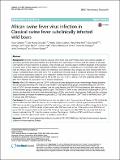Por favor, use este identificador para citar o enlazar a este item:
http://hdl.handle.net/10261/294939COMPARTIR / EXPORTAR:
 SHARE SHARE
 CORE
BASE CORE
BASE
|
|
| Visualizar otros formatos: MARC | Dublin Core | RDF | ORE | MODS | METS | DIDL | DATACITE | |

| Título: | African swine fever virus infection in Classical swine fever subclinically infected wild boars |
Autor: | Cabezón, O.; Muñoz-González, S.; Colom-Cadena, A.; Pérez-Simó, M.; Rosell, R.; Lavín, S.; Marco, Ignasi; Fraile, Luis M. CSIC ORCID; Martínez De la Riva, Paloma; Rodríguez, Fernando; Domínguez, Javier; Ganges, L. | Palabras clave: | CSFV CSF postnatal persistent infection Subclinical CSF ASFV Wild boars Viral load Innate immune response Adaptive immune response Disease |
Fecha de publicación: | 2017 | Editor: | BioMed Central | Citación: | BMC Veterinary Research 13: 227 (2017) | Resumen: | Background Recently moderate-virulence classical swine fever virus (CSFV) strains have been proven capable of generating postnatal persistent infection (PI), defined by the maintenance of viremia and the inability to generate CSFV-specific immune responses in animals. These animals also showed a type I interferon blockade in the absence of clinical signs. In this study, we assessed the infection generated in 7-week-old CSFV PI wild boars after infection with the African swine fever virus (ASFV). The wild boars were divided in two groups and were infected with ASFV. Group A comprised boars who were CSFV PI in a subclinical form and Group B comprised pestivirus-free wild boars. Some relevant parameters related to CSFV replication and the immune response of CSFV PI animals were studied. Additionally, serum soluble factors such as IFN-α, TNF-α, IL-6, IL-10, IFN-γ and sCD163 were analysed before and after ASFV infection to assess their role in disease progression. Results After ASFV infection, only the CSFV PI wild boars showed progressive acute haemorrhagic disease; however, the survival rates following ASFV infection was similar in both experimental groups. Notwithstanding, the CSFV RNA load of CSFV PI animals remained unaltered over the study; likewise, the ASFV DNA load detected after infection was similar between groups. Interestingly, systemic type I FN-α and IL-10 levels in sera were almost undetectable in CSFV PI animals, yet detectable in Group B, while detectable levels of IFN-γ were found in both groups. Finally, the flow cytometry analysis showed an increase in myelomonocytic cells (CD172a+) and a decrease in CD4+ T cells in the PBMCs from CSFV PI animals after ASFV infection. Conclusions Our results showed that the immune response plays a role in the progression of disease in CSFV subclinically infected wild boars after ASFV infection, and the immune response comprised the systemic type I interferon blockade. ASFV does not produce any interference with CSFV replication, or vice versa. ASFV infection could be a trigger factor for the disease progression in CSFV PI animals, as their survival after ASFV was similar to that of the pestivirus-free ASFV-infected group. This fact suggests a high resistance in CSFV PI animals even against a virus like ASFV; this may mean that there are relevant implications for CSF control in endemic countries. The diagnosis of ASFV and CSFV co-infection in endemic countries cannot be ruled out and need to be studied in greater depth. © 2017 The Author(s). | URI: | http://hdl.handle.net/10261/294939 | DOI: | 10.1186/s12917-017-1150-0 | E-ISSN: | 1746-6148 |
| Aparece en las colecciones: | (INIA) Artículos |
Ficheros en este ítem:
| Fichero | Descripción | Tamaño | Formato | |
|---|---|---|---|---|
| 49.pdf | 720,17 kB | Adobe PDF |  Visualizar/Abrir |
CORE Recommender
PubMed Central
Citations
14
checked on 25-abr-2024
SCOPUSTM
Citations
21
checked on 23-abr-2024
WEB OF SCIENCETM
Citations
21
checked on 26-feb-2024
Page view(s)
45
checked on 30-abr-2024
Download(s)
27
checked on 30-abr-2024

